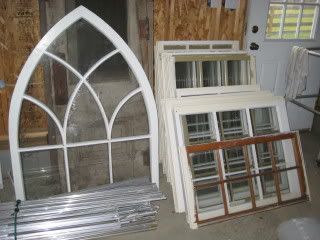My greenhouse is a bit unconventional. Instead of buying a kit to make a normal greenhouse, I decided to design one to use salvaged materials. This way I could make the building whatever size I want, and hopefully keep the cost down.
Prowling Craig’s List is a great way to get just about anything you could ever need. The windows we will use came from two different 1960’s era houses – 30 sashes from a house in Northern Virginia (all 32” wide), and 46 sashes from a house in Richmond (all 28” wide). The nice standard width of the windows made it pretty simple to design walls to use the available windows. In fact, we have enough of the 32” wide ones left over to use when we decide to remodel the workshop building.
The site is right behind the house, next to the water hydrant and convenient to power from the workshop.
The building is 12’ wide and 20’ long. The foundation is made of 6 x 6 timbers, most of which came from an old retaining wall – and were free. (I completely forgot to take a photo of the foundation.)
All the materials for the walls and roof are pressure treated – 4 x 4’s for the posts, 2 x 4’s for the top and bottom plates, 2 x 6 rafters, etc.
The skylights came from Craig’s List, too – 6 used Velux skylights (two of which vent).
As we got to this point (mid-October), the weather began to get cold. Instead of hurrying to devise a way to attach the windows to the frame and trim them out, we finished the roof and wrapped the building in greenhouse plastic for the winter. This gives us time to figure out exactly how to install the windows when we get back to construction in the spring, and I can use it now to root cuttings and protect rooted cuttings this winter.
The door is an old cast metal security-type storm door that I picked up at a thrift shop. When I saw that it had oak leaves and acorns in the design, I had to have it.
Let’s go inside. The inside walls are upholstered in bubble wrap (Craig's List, again) to help create a dead-air space for better insulation.
The south wall has shelves full of rooted cuttings and smaller potted roses that I want to protect from winter.
The north wall is the potting and work area. The cabinets, with the sink, are 1930’s vintage Jamestown metal cabinets, a Craig's List find from a house in Richmond. They are great for holding all my pots and supplies.
The west wall holds the mist system that I use for rooting rose cuttings. There are two shelves, each with 5 mist heads controlled by a Mist-a-Matic timer.
I expect that having a greenhouse to putter around in will make winters a lot more enjoyable. While the garden is frozen and sleeping, I can play with my roses and get things ready for next year.
Checking in.
2 hours ago























